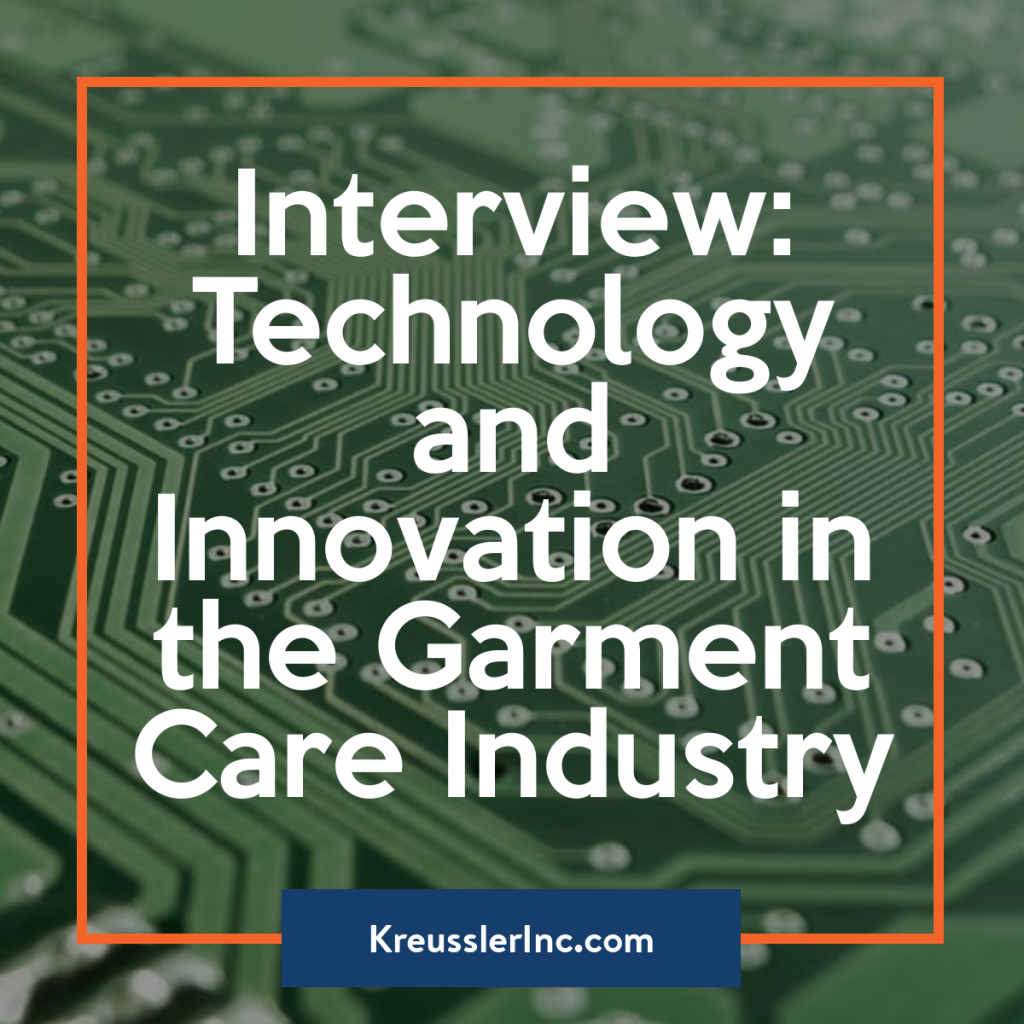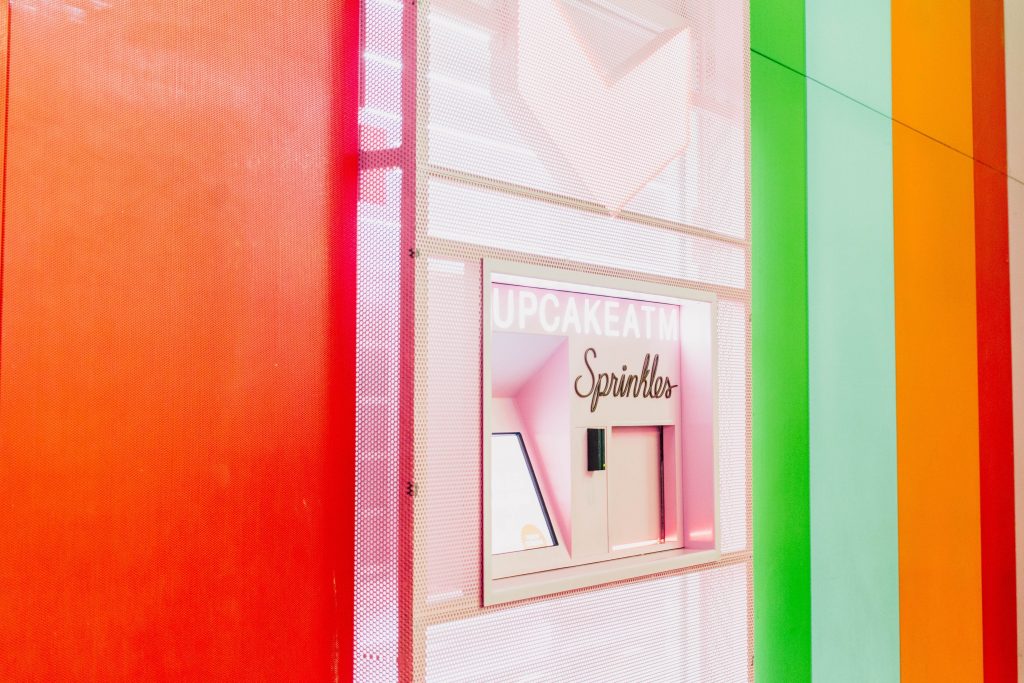This month Richard Fitzpatrick interviewed Brian Butler of Dublin Cleaners in Ohio to talk about innovative technologies in the dry cleaning industry.
This month Richard Fitzpatrick interviewed Brian Butler of Dublin Cleaners in Ohio to talk about innovative technologies in the dry cleaning industry.
Richard: I’d like to introduce Brian Butler, President, and CEO of Dublin Cleaners in the greater Columbus, Ohio, market. Brian, can you give us a little bit of background about your company? How did it start? When did you come into it? What your personal history?
Brian Butler: My grandparents started our family into the dry cleaning industry and had a large, successful chain, and delivery service from the 1930’s well into the 1960’s. During the 1970’s, during the oil crisis, the recession, permanent press and everything that was going on, their business really suffered. At the same time, too, their neighborhoods in the city really gentrified. They were not making it. My grandfather, unfortunately, passed at that time. My father, mother, and grandmother took the life insurance money and the equipment and staked it all on a piece of property up in Dublin, Ohio, which was a little more than 3,000 people, but Jack Nicholas had just built a PGA event-hosting golf course up here, and so they felt like that was the direction to go. They worked very hard and were very successful, and continue to be very successful.
Brian Butler: As a young person, I was raised in stretcher baskets, you know, between machines, and rode big wheels around racks of clothing coming around the plant. Once I was tall enough to stand on a bucket, I’d pull tickets from clothes before assembly and put things through the steam tunnel. As a child in a family business, me and my brothers just helped out. I earned enough to have to be put in the tax system. I had my first W-2 by the time I was 12, where my parents felt like enough money was moving from one hand to the other that it had to go into my tax ID, and I continued to do that through high school.
Brian Butler: Somewhere into the college years, I decided I really like computers, so I wasn’t going to have anything to do with the family’s business. My parents were okay with that. I went to work for a mathematics software company and was doing very well with that, but it was a small company. I didn’t feel like they had a long-term vision where I wanted to be.
When I was enrolling to get my MBA from Fisher at Ohio State, my father said, “It’s really interesting you’re having a career transition, I may start thinking about the same thing,” and he actively started looking to sell the business. He was 56 years old. I was 27. We had a sit-down and started talking about what that looks like, and what it would take for him to sell the business. It just wasn’t performing like he had wanted it to. It had grown to a point where it wasn’t based on sales anymore, it was based on performance, on earning. He said, “Why don’t you check with Ohio State and see if you could show up next fall, spend a year with me helping put in new IT, new control systems, you know, really kind of streamline this thing to work and create more cash flow. Then I can market it, and you can maybe even pick up your MBA and then some.” So why not, right?
Brian Butler: We are on year seventeen of that one year project. Along the way, probably within three or four years, we started the transition of ownership where we decided we were a pretty good partnership, and that I was going to stick around. Now I’m the majority shareholder, and they have a minority stake. My parents focus entirely on bridal. I run the business as a whole; they concentrate on bridal. They just got back from a three-week train trip from Chicago to San Francisco, stopping at most of the national parks along the way for a few days each. They come back and clean seventy or eighty wedding gowns, and then take a flight to wherever they’ll go next, never missing a wedding gown specialist meeting, and always seem to take on a two or three week trip on top of it, wherever that is. So, we’re kind of in an excellent position here where they’re in their 70’s; I’m in my 40’s. Everybody’s working hard in his or her lanes, and everything’s going really well.
Richard: That’s a great story. And I have to think that maybe your dad in the back of his head knew that it’s a sticky venture to get into. Once you’re there, you’ll see a lot of opportunity and promise. I have to imagine somewhere in the back of his head he was thinking, “I’ll do this and maybe after a year, he’s going to like it enough that he wants to buy it.”
Brian Butler: And in a manner of speaking, he verbalized it. He said, “One of the great things about this will be that you’ll never have to wonder if you wanted to be a part of this after we sell it.” He said, “If you help with this project and you don’t grow fond of this business and want to slow down that process, then we’ll all know.” He said, “I will never have to wonder if I should have encouraged you, or highlighted the opportunity. Also, you know what your options are. They’re available, and you’ll do what you’ll do with eyes wide open.” It was part of the discussion in the beginning, but there was no, “Hey, we’re going for the long haul here.” It’s like, “Let’s take this year and let’s see where it goes from there.”
Richard: As of today, right now, Dublin Cleaners operates one sizeable central processing plant. You occupy how many square feet?
Brian Butler: I think 13,000.
Richard: Do you have satellite stores, routes that feed into that as well?
Brian Butler: We have five satellite stores and fourteen routes.
Richard: The topic of the conversation is innovation and going beyond merely paving cow paths, which is for a long time what seemed to be happening in this industry. You know, things weren’t really changing, but the equipment had a different shape to it, or maybe there were different buttons on it. However, it did the same thing.
Brian Butler: Right.
Richard: Being able to separate that from equipment or concepts, business practices that were maybe not paradigm-shifting, but certainly different enough that they required some detailed thought and process. How important is innovation for Dublin Cleaners and the garment care industry as a whole?
Brian Butler: Well, I think it’s the difference between survival and failure because the consumer is changing their needs and demands at such a rate, it’s unbelievable. They want to know the nth degree almost in real time about things that I think previous generations took for granted or considered tedious. Having these mobile apps, and production track, and route tracking, automated assembly and garment storage, this ability to create dynamic routes that change every time you go out based on efficiency and to be able to hit a real-time push notification, text or email when the delivery has been made. It’s just amazing.
Brian Butler: And the funny part too is you can see how much they desire it in the fact that if you go out on any dry cleaning route, how many of these new tracking doorbells and cameras that you’ll see out there. People, they want access to an incredible amount of information, so the point of sales software that is available, and we use Spot, creates that vehicle. You can engage your customers on what seems to be a one-on-one basis and a scalable way. We used to have so much trouble getting in contact with people about holiday weeks with our schedule changes for routes. Now, it flows as if we haven’t even changed the days.
Brian Butler: We have an effective way to communicate, map, and contact thousands of people per night through email and text. They still put their trash cans out on the wrong day, but they get their dry cleaning out on the right one.
Richard: And interestingly, that’s a piece of technology that didn’t exist five years ago. Being able to have that touch point with your clients.
Brian Butler: The nice thing about it too is that it can be ala cart, where they can decide what they want to know when they want to know it and turn these contacts on, this information off. It’s so flexible, and it’s self-driven by the client. They log in through customer connect, they download the app, and whatever they want to know they can know. We used to have three full-time office personnel; we’ve gone down to an administrative assistant that works maybe 25 hours a week, and a bookkeeper that works about 12. So we have one full-time equivalent in our office now.
Brian Butler: We used to have four full-timers, generating statements, answering accounts receivable telephone calls, making sure that this preference is that, everything else. Now, people open the app, look at what happened. If it hasn’t already hit a credit card on file, make an online payment, check if that item didn’t come back and they didn’t notice, but we sent a push notification for split order and why they can go in and look and see. I mean, we’re at a point now where we’ve reduced the telephone ringing an incredible amount. None of that was revenue generating. None of that was value added. It was quite expensive, too, to pick up the phone, search in the software.”Okay, Mr. Fitzpatrick, I guess maybe you didn’t see the note…”
Brian Butler: It’s become about communication of information. That seems to be the next degree of service. The product quality, that’s always had to be there. Also, smiling customer service, that’s always had to be there. However, people want to pick up their smartphone and check on something at eight p.m or midnight or something else. They can now. Or make a payment. We think it’s fantastic.
Richard: This particular piece of innovative technology is available through a trusted vendor that you’ve been using, Spot, and some of the peripheral companies that they work with, but there’s a really low barrier to bring technology into the professional textile care industry. You just have to rent space at a trade show and talk to people about whatever it is you think is the next great thing.
Brian Butler: Yup.
Richard: How do you analyze and consider new technology before you decide whether to implement it? Is it like a SWAT process where you review it and try to make a determination does this fit for us? Alternatively, do you rely on peers in the industry? How does that process work?
Brian Butler: Well, yeah. It is. I guess a SWAT situation. It’s a little bit of feel; it’s a little bit of knowing the market. We’re able to use tools like Survey Monkey to send a simple survey to a few hundred of our top clients, and ask the question, go out on to LinkedIn or Facebook, and say, “Hey, we’re thinking about this, we’re thinking about that.” You know, 1,000 followers. You start to see where the trends lead.
Brian Butler: There is an interesting difference though about what people will say they like or say they want, and then where they’ll put their money, sometimes you have to read between the lines. An excellent example of that is we’re still trying to figure out the valet folded laundry. When we sample surveyed some of our top clients on that, we just got gangbusters concerning, “Oh, I love that. I’d definitely use it.” And everything else. Of those people that gave that answer, just those people, we sent them all a certificate for a complimentary initial order as we launched it at one of our locations. I think fifty of them gave us that answer, and I think we got three of those who redeemed the offer.
Brian Butler: It was free to people that said “definitely” and “absolutely.” They would do it at the price that we were thinking about doing it at. The initial order was three. We got something like a six percent response rate.
Brian Butler: So, there’s a great example of don’t count your chickens.
Richard: That speaks volumes. People liked the concept and the idea of having it available, but don’t want to pull the trigger on using it.
Brian Butler: That reminds me of a story. When we first put in our first 24-hour kiosk in one of our stores, and we would all spend time trying to get as close to the customer contact as we could. I’m in there one afternoon, and there’s a little bit of a line at the counter. I’m kind of standing over by the machine. I say, “Come over here. Let’s use this. This will help you bypass the line.” She says, “Oh, no thank you.” “No, I’ll help you. I promise.” She said, “No, I really don’t like those things. I want to see Cindy (or whomever it was) over there.
Brian Butler: She knew her by name, so I knew that it was genuine. She said, “But it makes me happy to see you have that.” I said, “Well if you don’t wish to use it, help me understand why that makes you happy.” She goes, “Well, it’s an example that your company is willing to invest in all the latest innovation that leads to our happiness as customers, and I’m sure some of the other things you’ll do I will use.” I thought I could have gotten some wallpaper and a fake monitor, and she would have been happy, you know?
Richard: A little Trompe-l’oeil kiosk and they wouldn’t have known the difference?
Brian Butler: Yeah, exactly. You know, just put an old vending machine over in the corner and say, “Fresh dry-cleaning.”
Richard: When you’re trying to decide on what technology to invest in, do you need to see immediate ROI on that or are you willing to say, “I’m going to put this in, but I don’t think it’s going to move the needle for at least eighteen months.”
Brian Butler: It’s a good question because when we feel like we can confidently chart an accurate ROI, that tells you everything. Eighteen months would be a long time to start seeing any payback in our industry. We don’t have long B2B closing cycles and long reaction times, so I struggled to imagine something that didn’t start to move the needle pretty early that would start to move it in eighteen months. I can’t quite imagine such a thing.
Richard: When you look at an investment, you want to see it be able to influence productivity or the customer experience pretty quickly?
Brian Butler: Yes.
Richard: What was the last significant innovative investment that you’ve made at Dublin Cleaners?
Brian Butler: I’d probably say putting production track entirely into our production area was our last significant innovative investment. You know, where every presser, sewing and alterations person, and the spotter all have a tablet. They’re getting information, getting tracking count, tracking production flow and then putting the data on a 70-inch TV up on the wall that has all the public posted stats of where the team is, and where all the individuals are throughout the production then.
Richard: Did that implementation go smoothly for you?
Brian Butler: Yes. At first, there was some resistance because it was new and some of the pressers thought, “You’re adding more work for me.” However, I think in some time they started to realize how sturdy and how accurate it was, and it had a powerful psychological impact because we do pay piece rate on consistent items like shirts, pants and some of the other pressing items that are very consistent, like some of our golf shirts and some of those kinds of things. So, piece rate pressing, you would think that those people are going to reach their high-level natural flow.
After we put this sort of stuff in, we started to see people who had years of experience and have been consistent but plateaued lift by anywhere from ten to twenty percent in their productivity. When asking them, it was like, “I know I can outrun him or her.” They started eliminating their slow hour, or their slack hour and staying at their rate throughout the day. It was the psychological impact of the public posting. It made me think about a quote from Napoleon that says, “There’s no amount of money any man will lay his life down for, but he’ll gladly do it for a little bit of ribbon.”
Richard: That is good.
Brian Butler: Yeah. I still remember talking to two presser’s, and their piece rate had increased ten or twenty percent. Why didn’t you achieve that before? “My name is up there.” Okay.
Richard: Kreussler is a detergent manufacturer, but you have many partners and stakeholders that contribute to the success of your business. Where would you like to see companies like Kreussler or other manufacturers invest R and D in? Where would you like to see innovation come from in the next few years?
Brian Butler: Wow. That’s a big question. You know, something that I don’t hear enough said about is and this might be a psychological or anthropological shift that we just can’t push the other way is the value of dressing up and looking sharp. It’s really fascinating to look at people in society today and see how casually they show up for things. Where did all that go? Now you’ve got a guy in cargo shorts and flip-flops wearing a $20,000 Rolex.
Brian Butler: He put the money into a watch. Why didn’t he dress like an adult? So maybe marketing that psychology of, all right, you’re trying to make your way up in the world. Well, here’s the small idea we have that you dress like somebody if you want to be somebody.
Richard: I think that would be a healthy change not only for our particular industry segment. We had an interview last month with a couple of senior management partners in my company about sustainability, and specifically about the garment manufacturing industry and the kind of conclusion that both of these ingenious gentlemen had was that people need to start valuing their textiles a lot more than what they currently are. There needs to be a break from this low-cost, fast fashion and people making investments in clothes that are well made and sustainably made, and then care for them properly.
Brian Butler: Right.
Richard: And I think that will have a trickle-down effect not only in our industry but also the overall health of a lot of different economies and the environment.
Brian Butler: Yeah, I mean, unless we all work together to find ways to raise the overall volume to the industry, this is just a lengthy game of Lord Of The Flies.
Richard: If that’s the case, then I hope I’m the last one holding the conch.
Brian Butler: Yeah, exactly.
Brian Butler: But it really is. Okay, so I’m in my 40’s. I remember working in the plant in the 80s and just get this stuff comes in and everybody that came in and out of the door, not just a guy in a dress shirt and a pair of slacks, but dress shirt, tie, pants, maybe vest, jacket, maybe even a sweater, sometimes a matching hat. I can only imagine what it was like in the 1960s and before then. You go back to my grandparent’s era, and even folks who worked in factory floors, if they went out after work would go home, clean up, put on a nice suit and go out looking like somebody. Even the gangsters wore suits, you know?
Richard: I’ve got two more questions for you.
Brian Butler: Okay.
Richard: The first one is a comment I made earlier about the low barrier to entry in this industry, especially for technology and things like that. For lack of a better term, there’s much unproven bunk that has been introduced to the market.
Brian Butler: Yeah.
Richard: This stuff is being sold to dry cleaners, and many times people make investments because they’re being told it could save money, or it’s an improvement, and in the end, it hurts the company and lowers the bar. Do you think that there should be more of a vetting process before companies can bring products to the marketplace?
Brian Butler: I believe in pure capitalism, so I don’t think that there’s anybody that should tell us how to start up, where they can and can’t be based on what they have or haven’t accomplished so far because we could squash innovation. When I choose who we’re going to invest with, a lot has to do with judging the people that are involved, judging their body of work, what’s their longevity. I am conservative.
Brian Butler: I like when the long-term reliable, steady players stay ahead of the curb on things. And when they offer something, such as Kreussler and some of the POS systems that we have now, I think they can be relied upon. And they can miss from time to time. And that’s okay because it won’t take them under. However, it seems a little scary to put all your eggs in the basket of someone who has been around four or five months and is still trying to get enough funding to keep running. You just kind of wonder, “Will the lights go out one day?”
Richard: Last question would be: what do you think it’s going to be like to walk through Dublin Cleaners in ten or fifteen years from now?
Brian Butler: With things changing so fast, I would be challenged just as much with that questions three years from now.
Brian Butler: Every time I set a course, it seems like that we’re re-setting the course within quarters if even years, and so ten years from now I think that we continue to trend to a place where people are engaged in the steps of our process that matter to the consumer and that automation and electronics are doing everything else and keeping it consistent. I see automation to the nth degree. It’s hard to answer that question much further because ten years ago we didn’t have iPhones. Think about that for a minute.
Brian Butler: Everything we’ve discussed right now, the kind of nucleus of it, is devices. There are devices throughout my plant, and there are devices in every consumer’s hand that didn’t exist ten years ago. They communicate with one another as much as that client wants. All this information has accumulated, and to the client, it’s like a buffet, takes from the buffet that which they wish. To tell you what I see ten years from now, I feel like I don’t have enough pieces of the puzzle to even answer.
Richard: Still a good answer.
Brian Butler: Yeah, thank you.
Richard: Brian Butler, I’d like to thank you very much for taking some time to talk to us. Dublin Cleaners is a fantastic operation, and we’re very proud to have you as a client. I wish you all the best.
Brian Butler: Thank you, Rich. We’re thrilled to be your client. You guys are among the top fold of our suppliers and couldn’t be happier.
Richard: Thank you for that.




